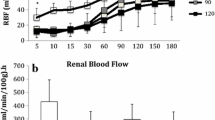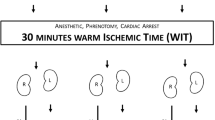Abstract:
A critical shortage in the kidney donor pool has led to a renewed interest in non-heart beating donors (NHBDs). As warm ischaemic tissue injury is a characteristic of NHBD, it is therefore crucial to screen such kidneys for viability to disqualify kidneys that will never work, i.e. develop primary non-function. Viability screening is somewhat time-consuming, usually involving a combination of donor history, visual assessment of the donor kidney at procurement and monitoring during hypothermic machine preservation. Machine perfusion of NHBD kidneys enables physical characteristics to be evaluated by perfusion flow rate and pressure. Glutathione S-transferase (GST) is an established kidney injury biomarker, but its prolonged assay time may result in delays in any potential transplantation. Alanyl aminopeptidase (Ala-AP) has been developed as an alternative novel biomarker of ischaemic renal injury. A porcine NHBD model with differential ischaemic renal injury, using heparin ± streptokinase in the initial in situ flush solution, was developed to evaluate the two biomarker enzymes, GST and Ala-AP. Two groups of 16 porcine NHBD kidneys (heparin alone or heparin + streptokinase) were machine perfused for 4 h, with documentation of pressure, flow, resistance and temperature and samples of kidney perfusate were taken at hourly intrevals. Wedge sections of the kidneys were analysed at termination of perfusion. Histopathology of renal wedge sections, machine perfusion physical parameters and biomarkers demonstrated the differential renal ischaemic insult. The two biomarkers, GST and Ala-AP appear to be correlate with the degree of ischaemic injury and with each other. Mild ischaemic injury occurs in the streptokinase-treated group, with lower efflux of GST and Ala-AP. Assays for Ala-AP activity in humans are significantly shorter than the comparative assays for GST, enabling early decision making on viability. This can, therefore, facilitate transplantation of the potential NHBD kidney within the recommended 24-hour period of cardiac arrest of donor.
Similar content being viewed by others
Author information
Authors and Affiliations
Rights and permissions
About this article
Cite this article
GOK, M., SHENTON, B., PEASTON, R. et al. Comparison of Glutathione S-Transferase and Alanyl Aminopeptidase as Viability Markers in a Porcine NHBD Model. Comp Clin Path 11, 140–147 (2002). https://doi.org/10.1007/s005800200013
Issue Date:
DOI: https://doi.org/10.1007/s005800200013




